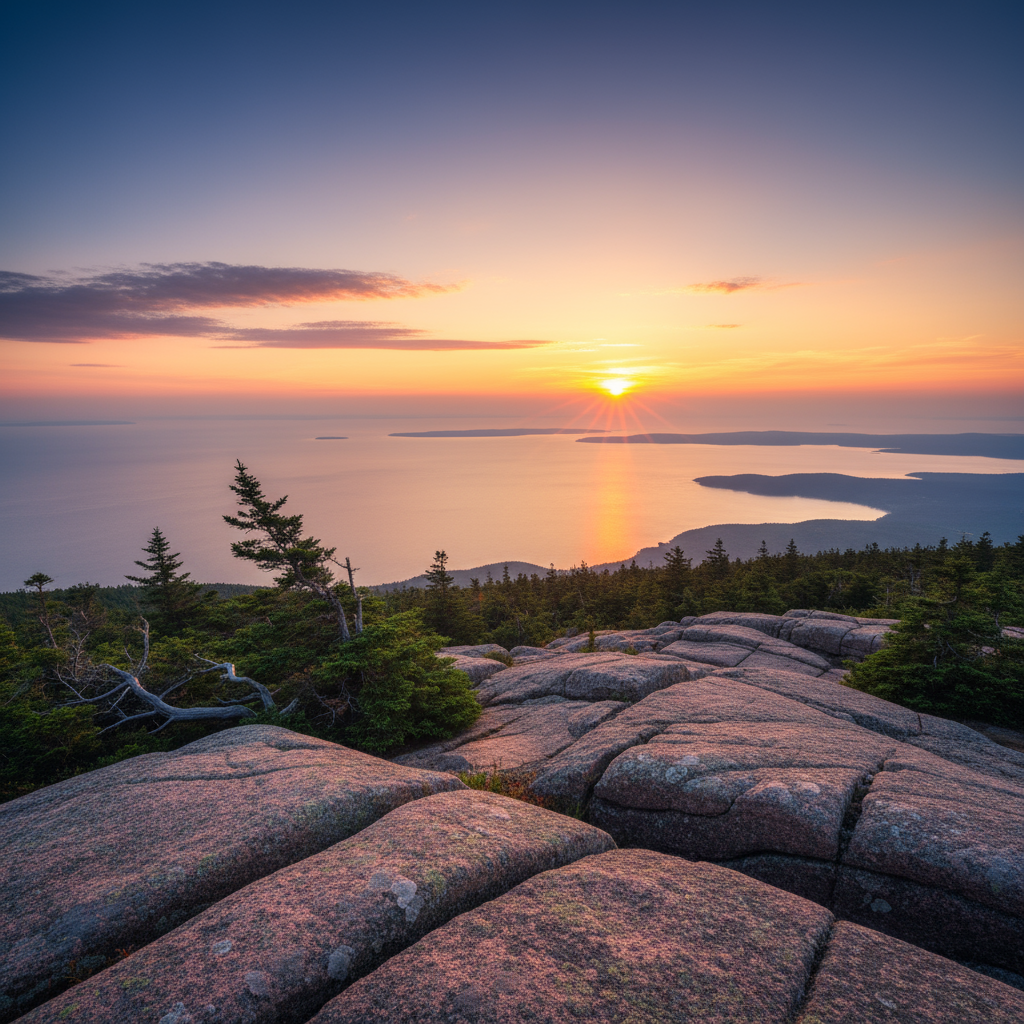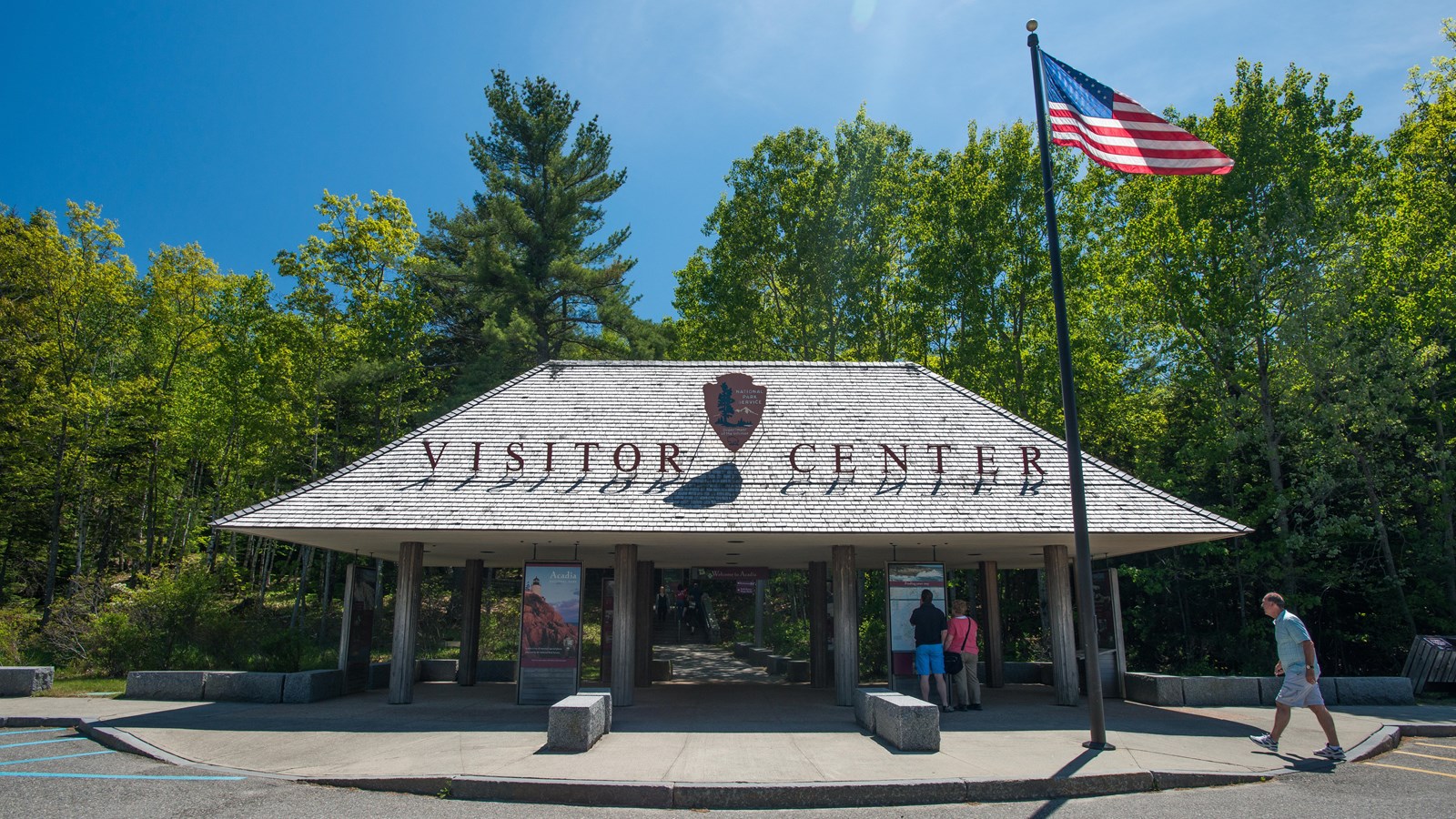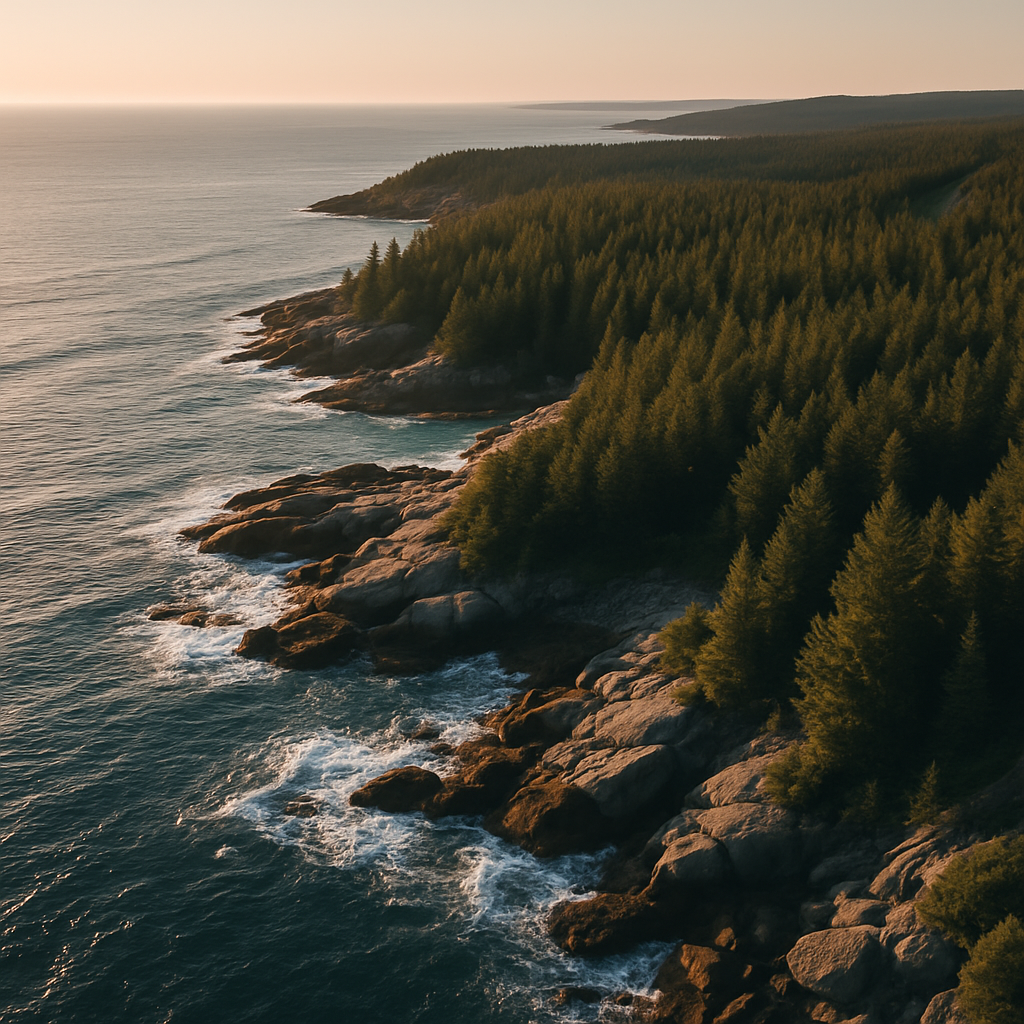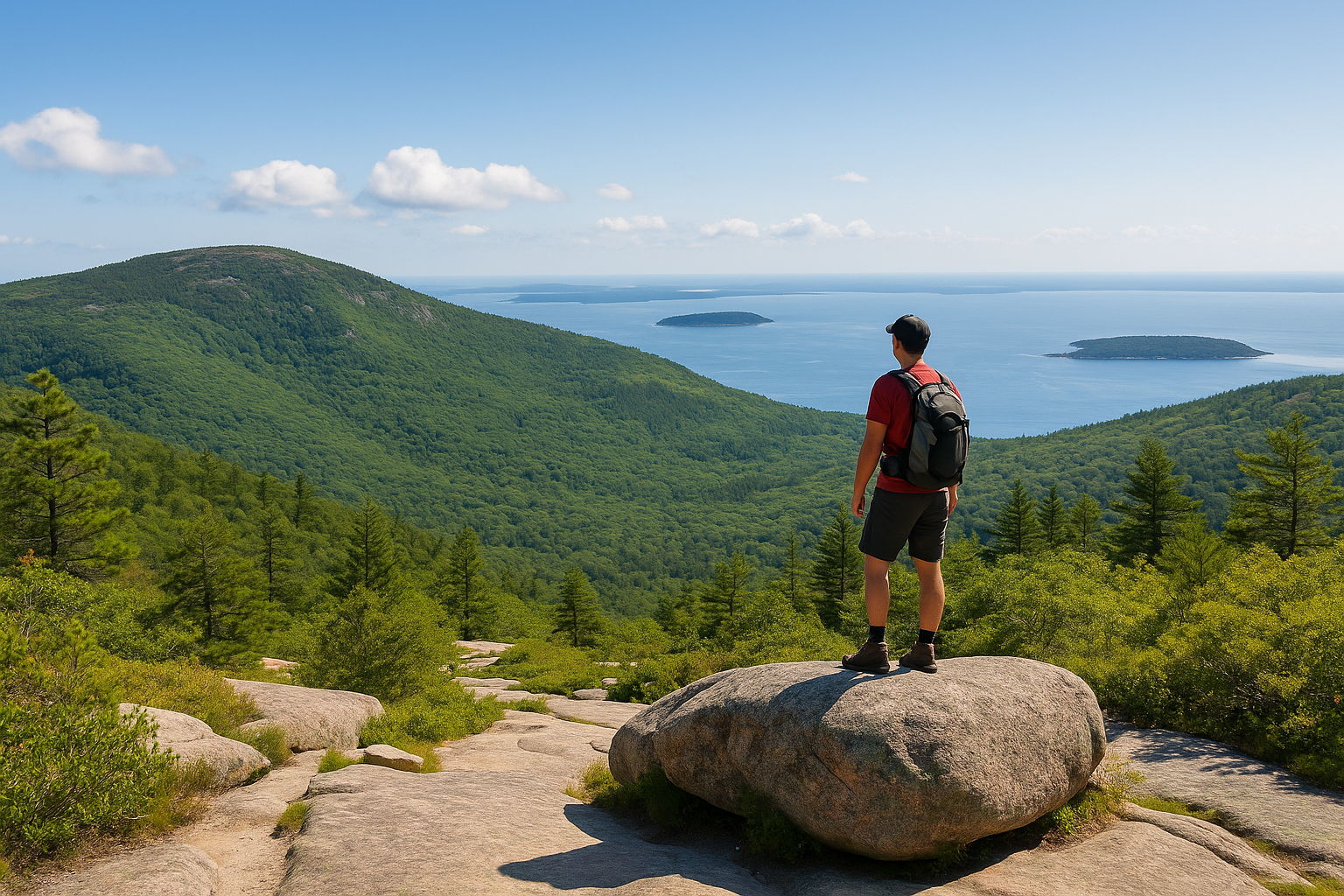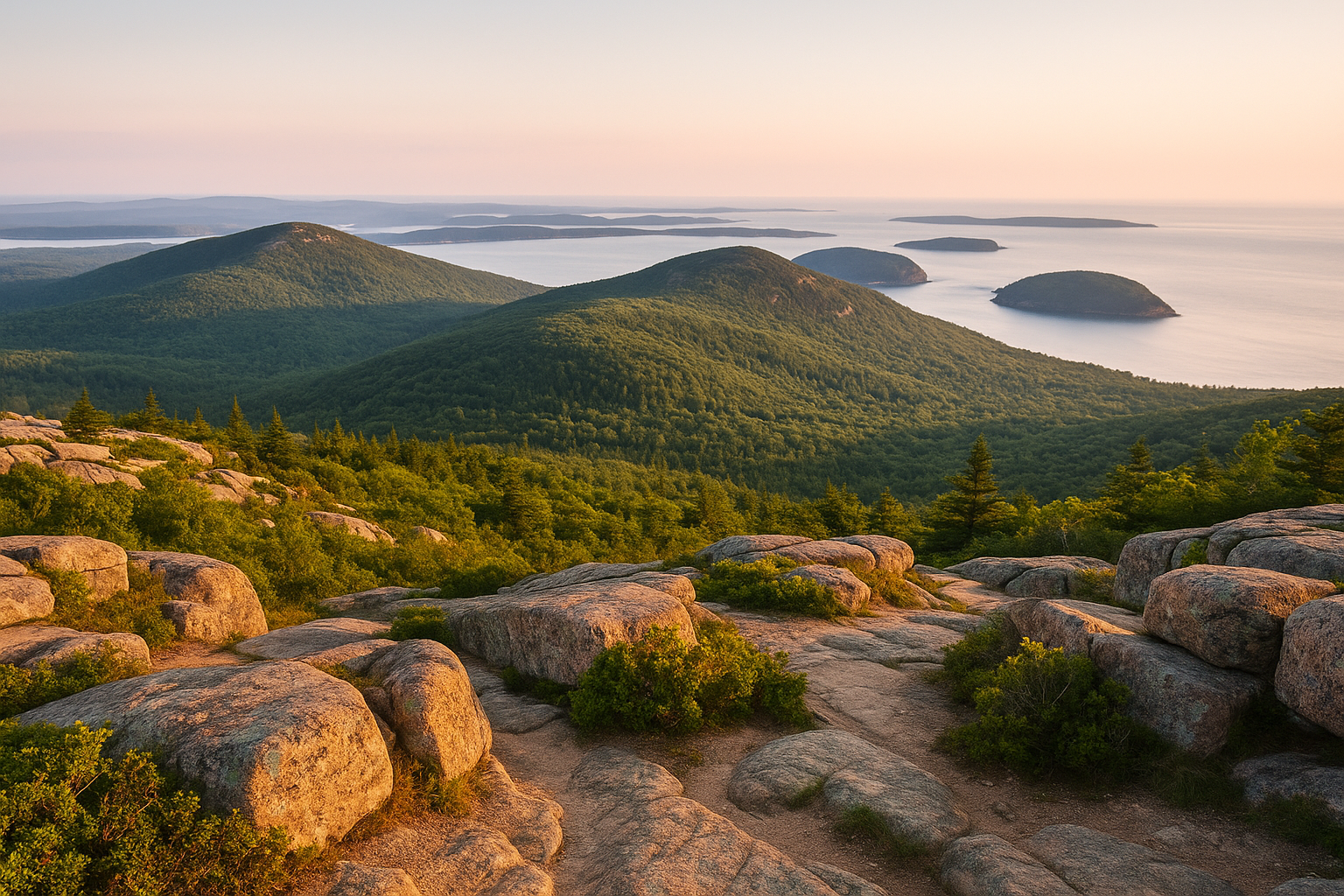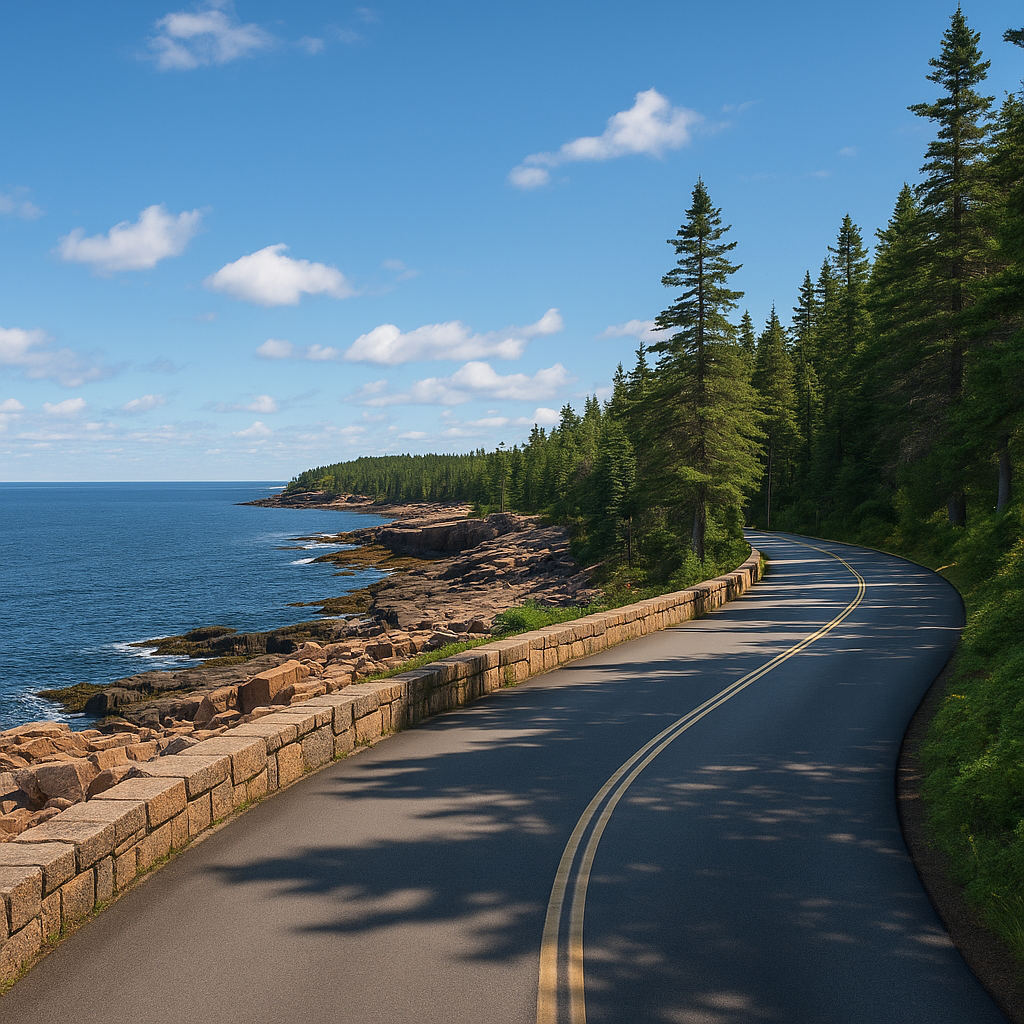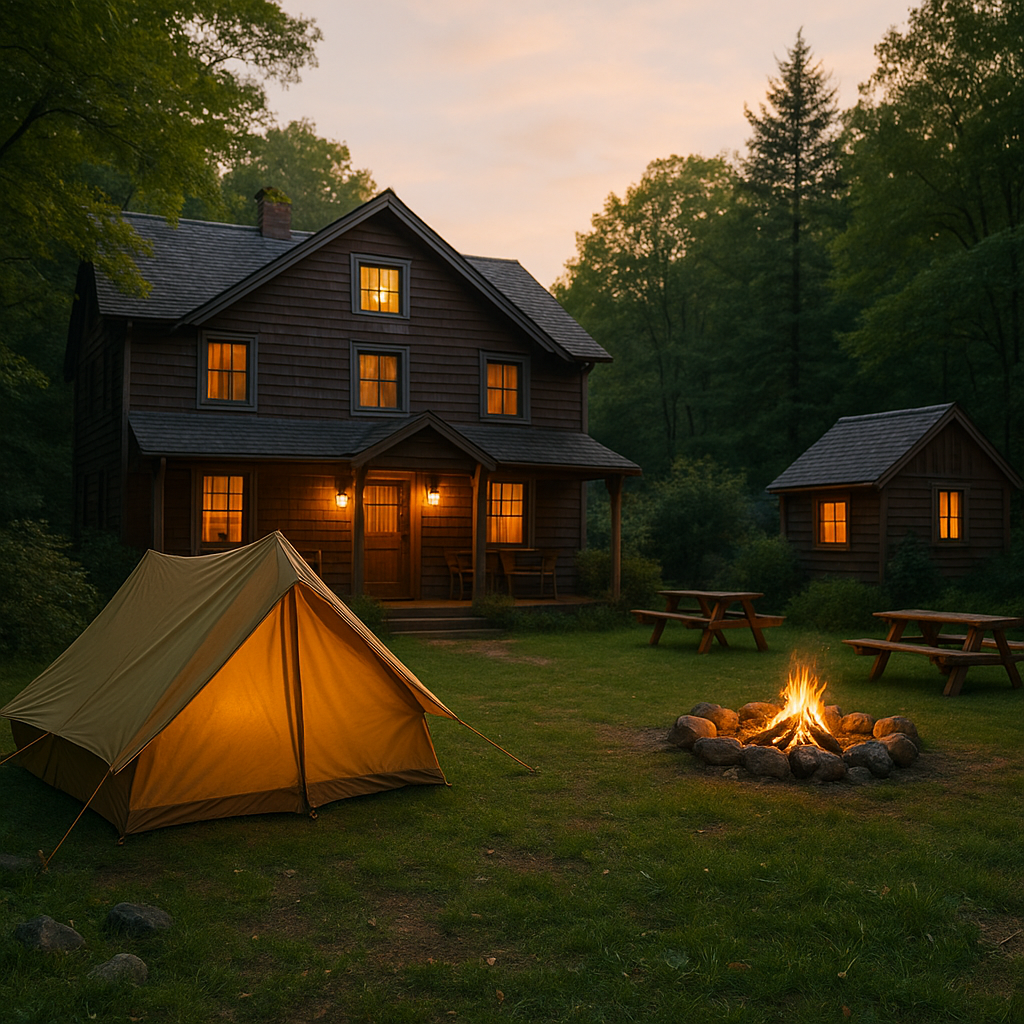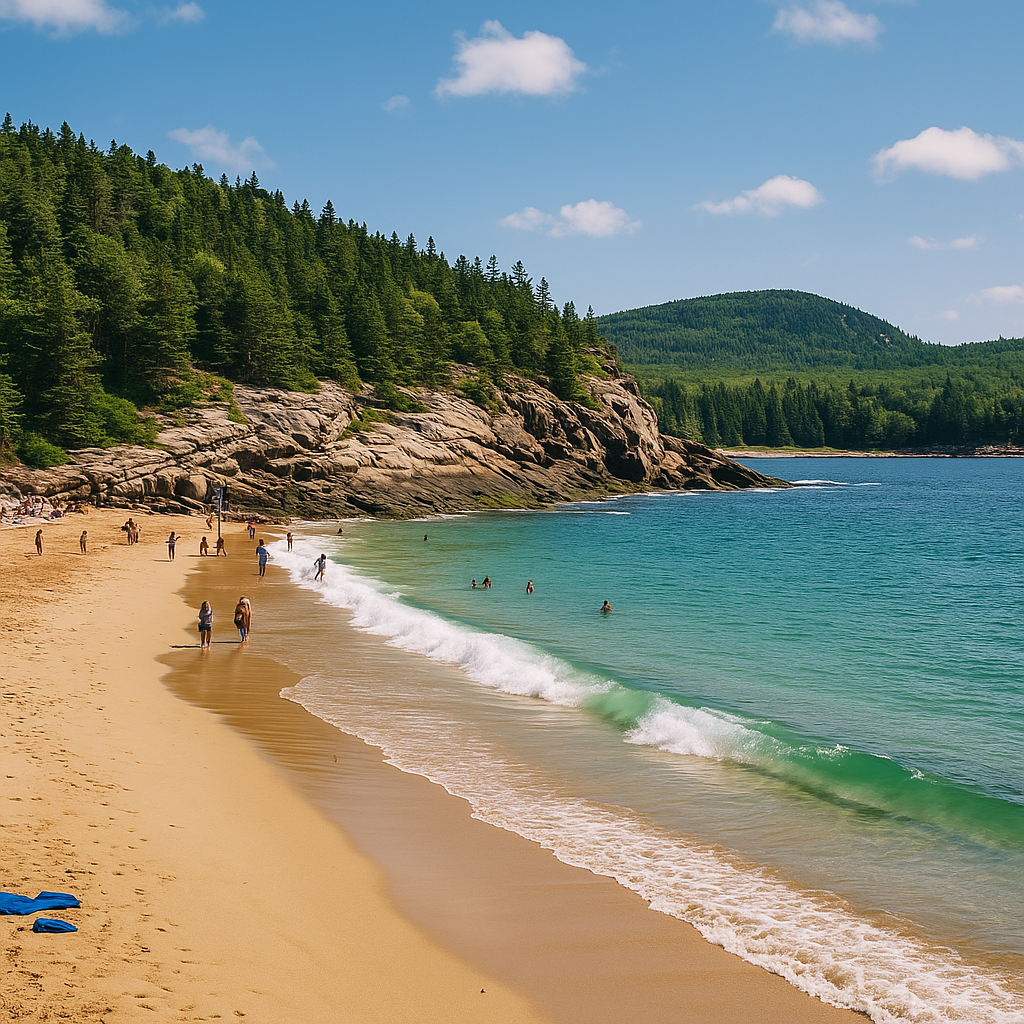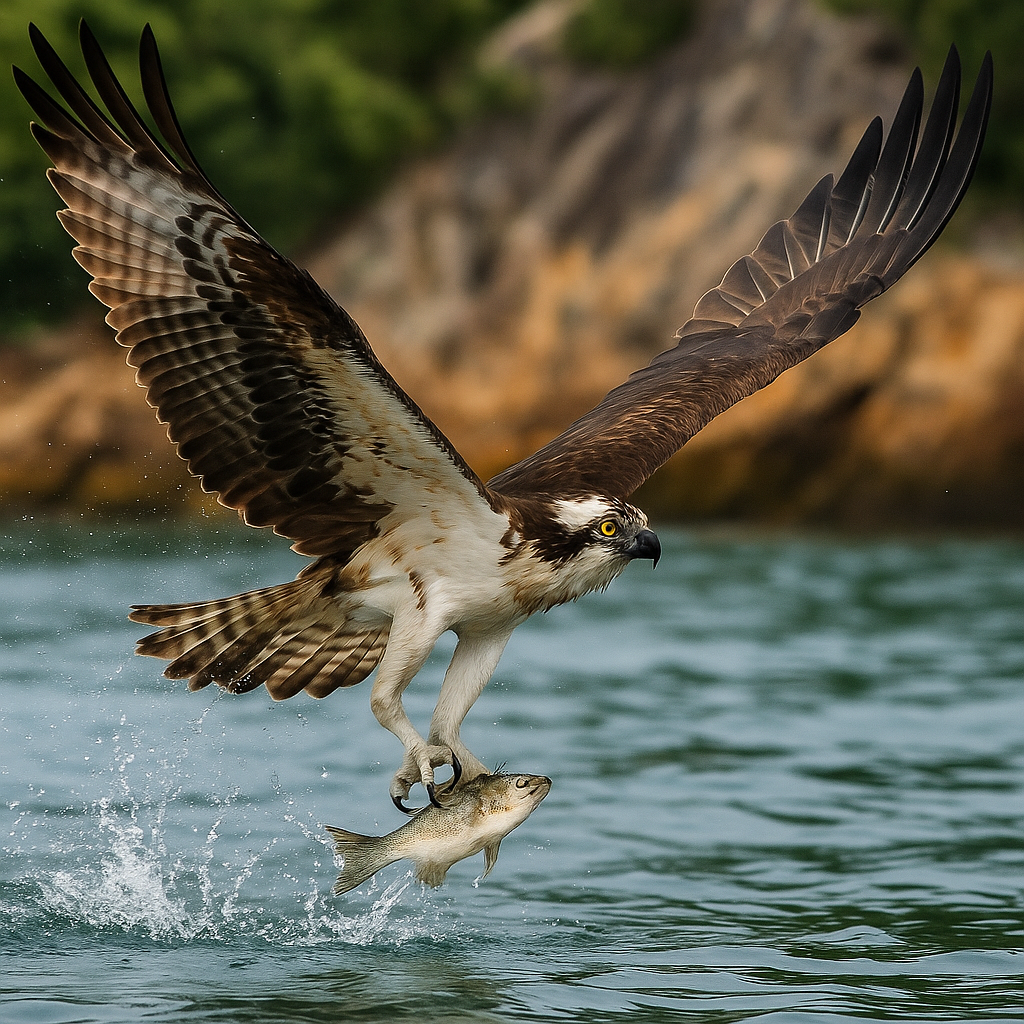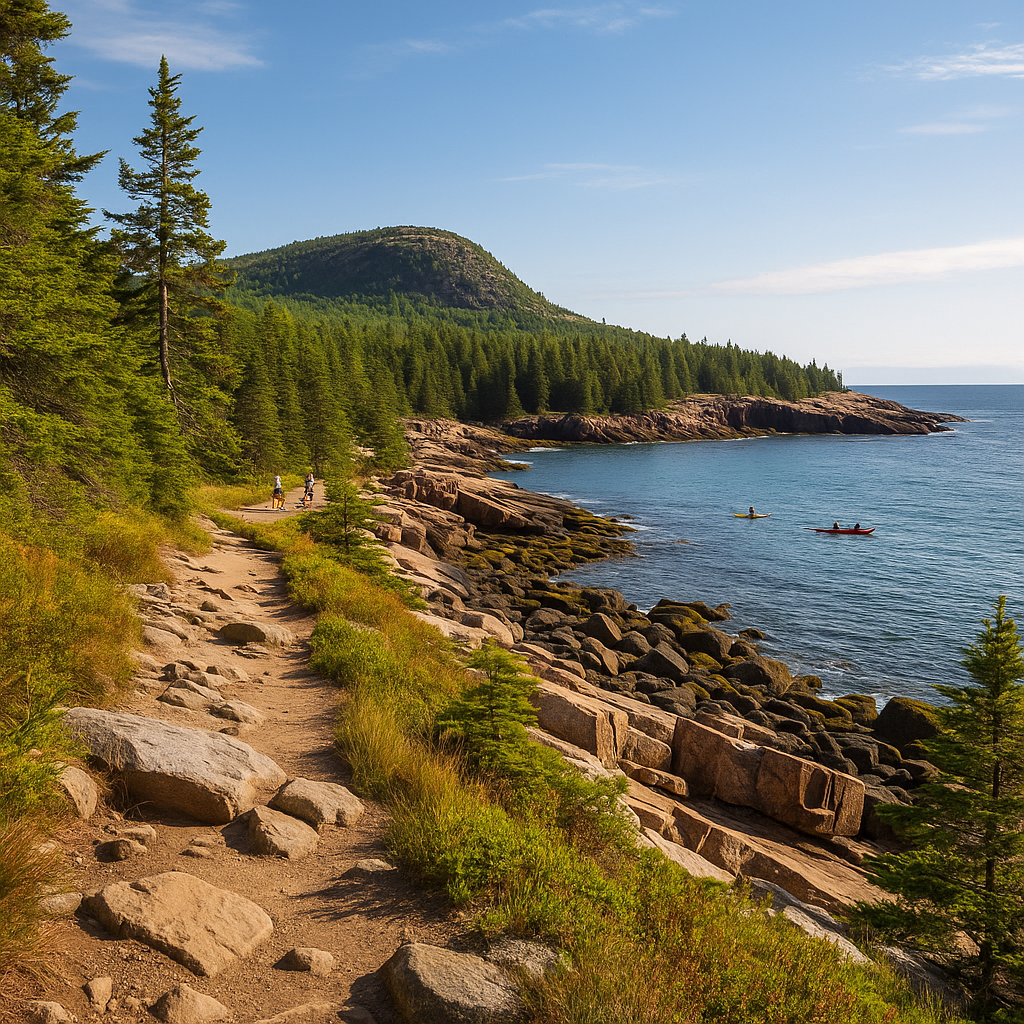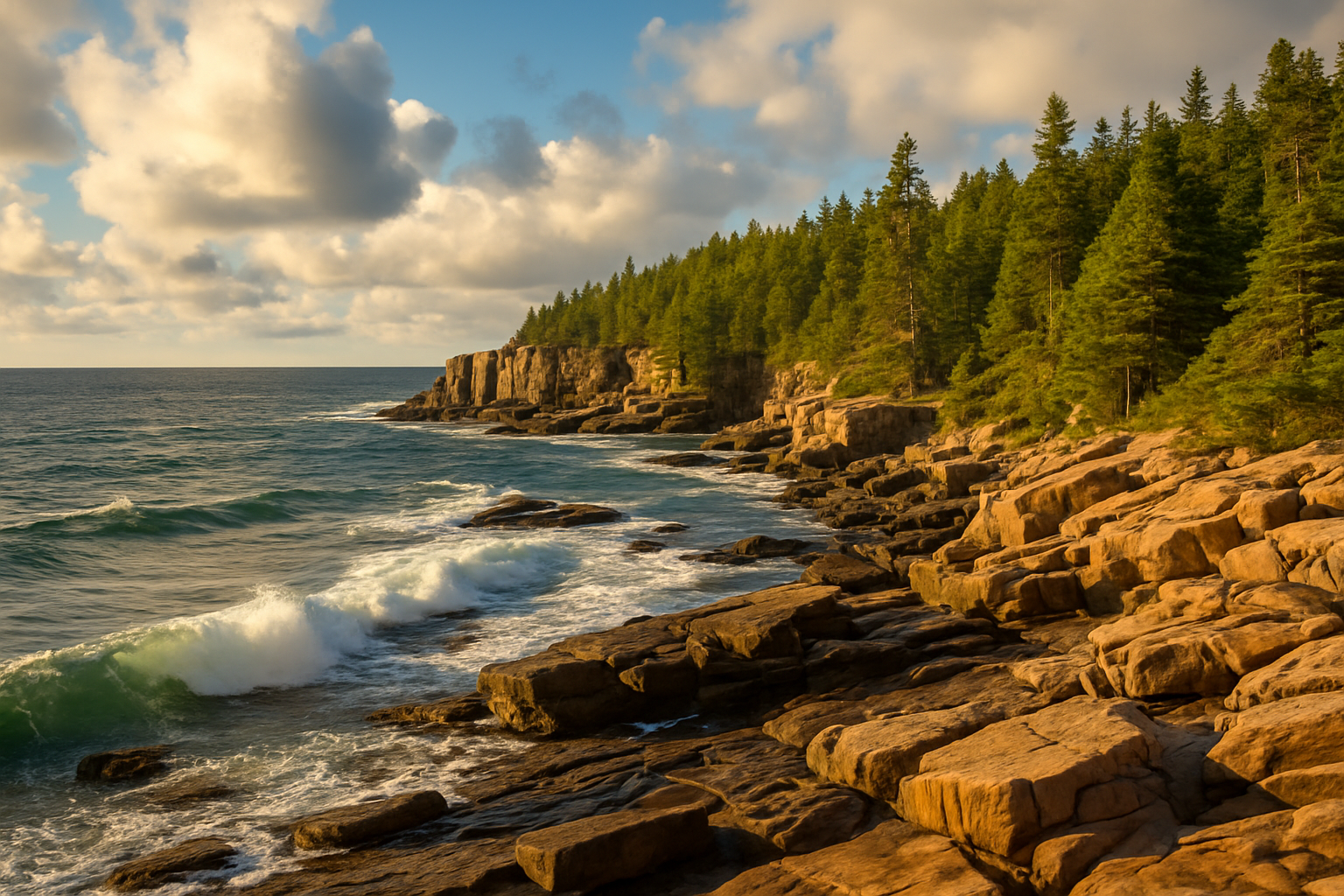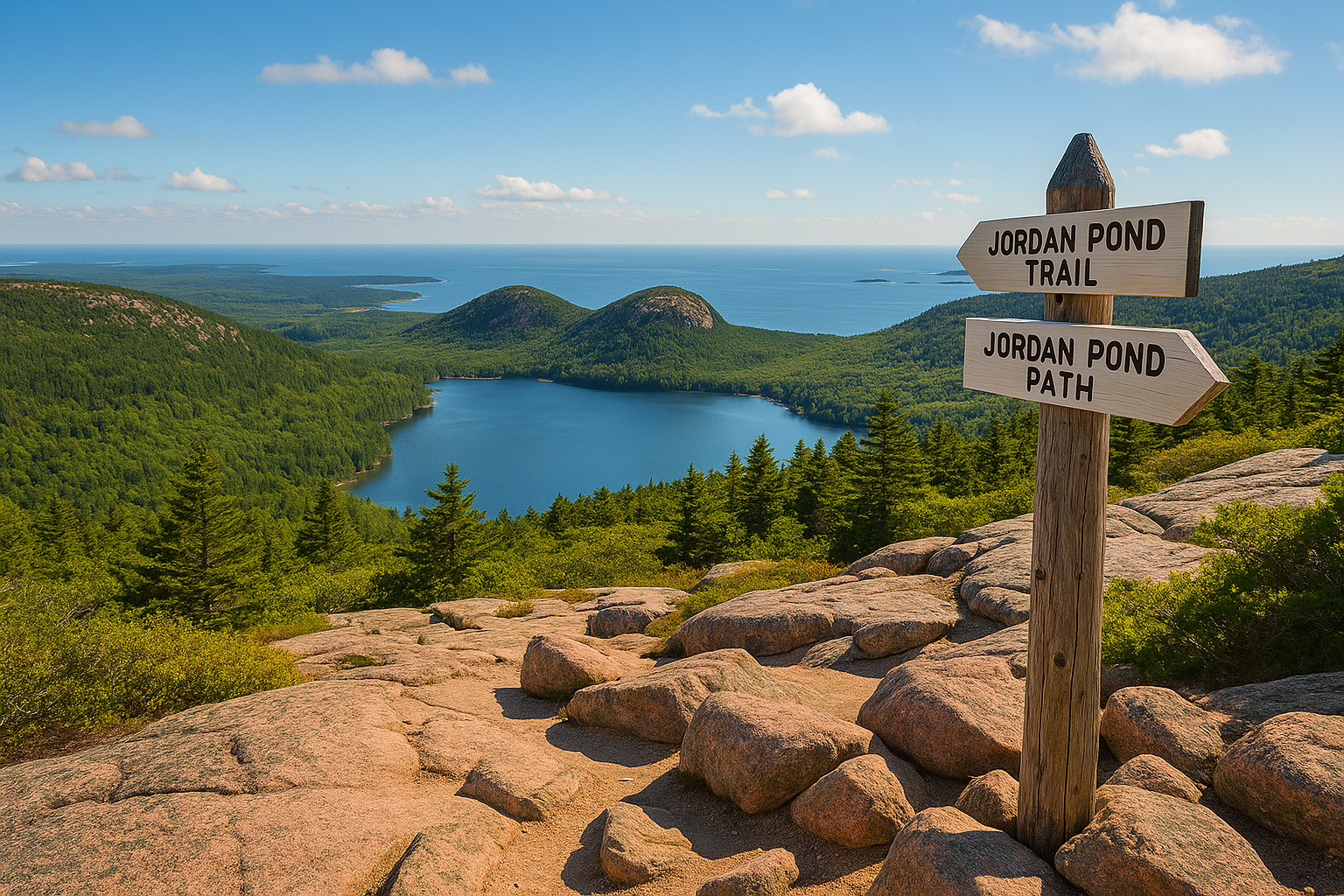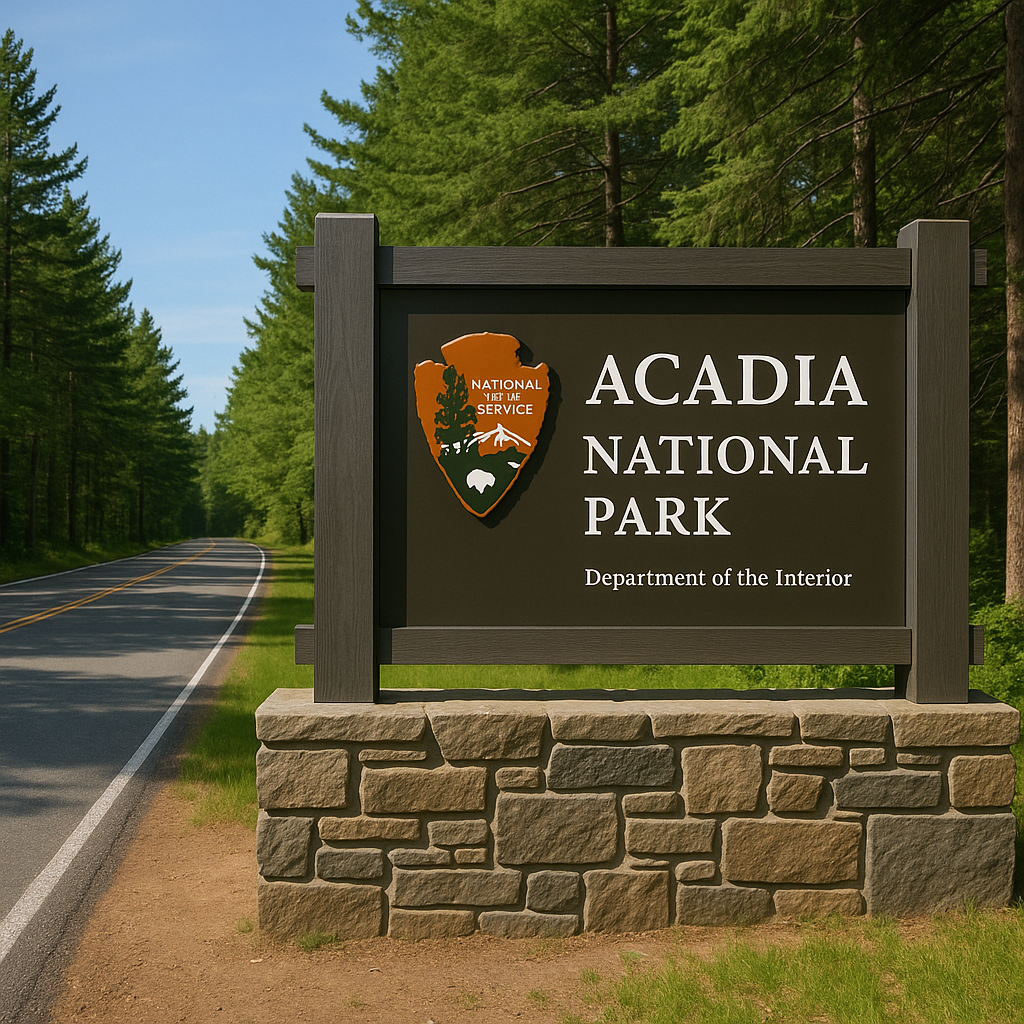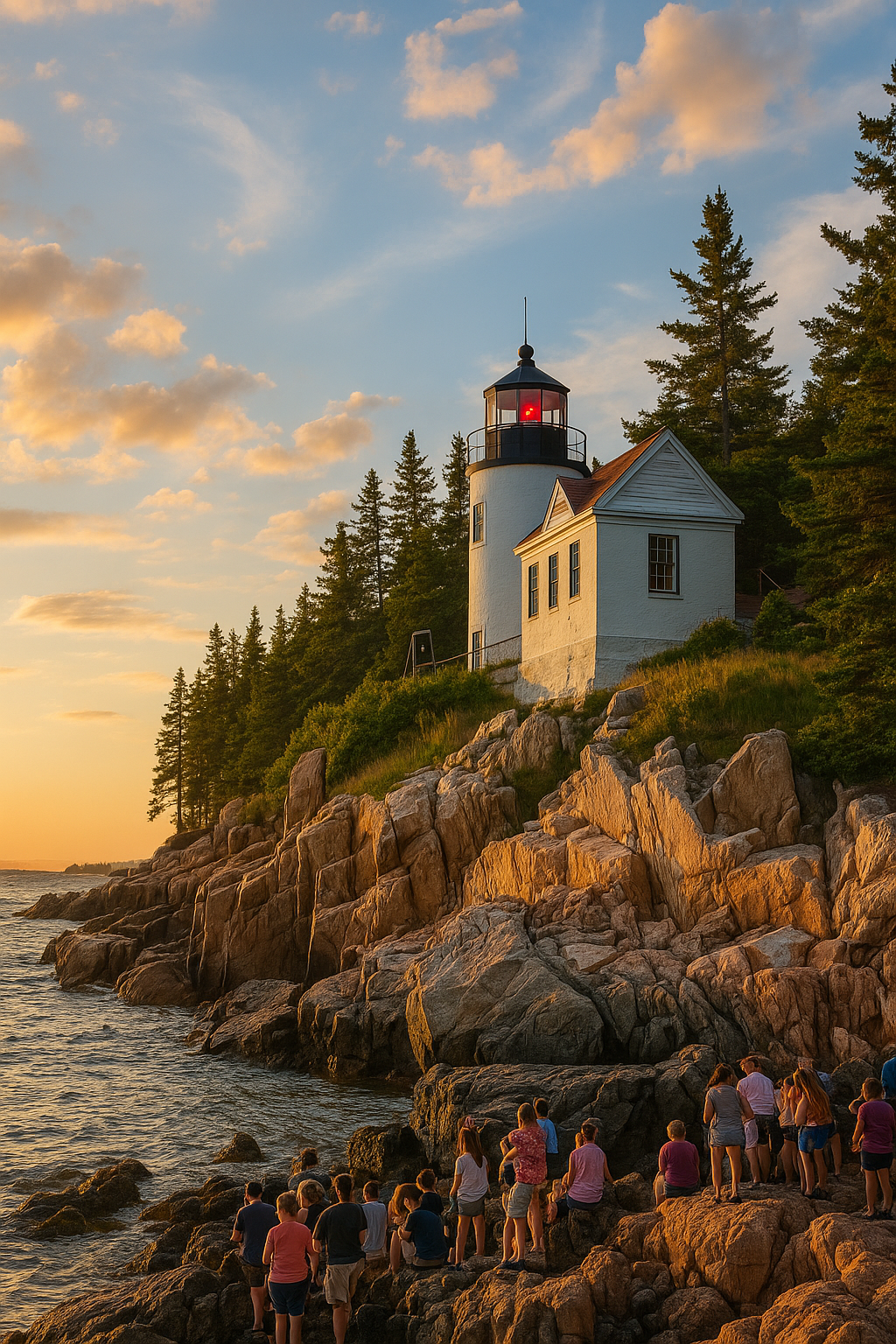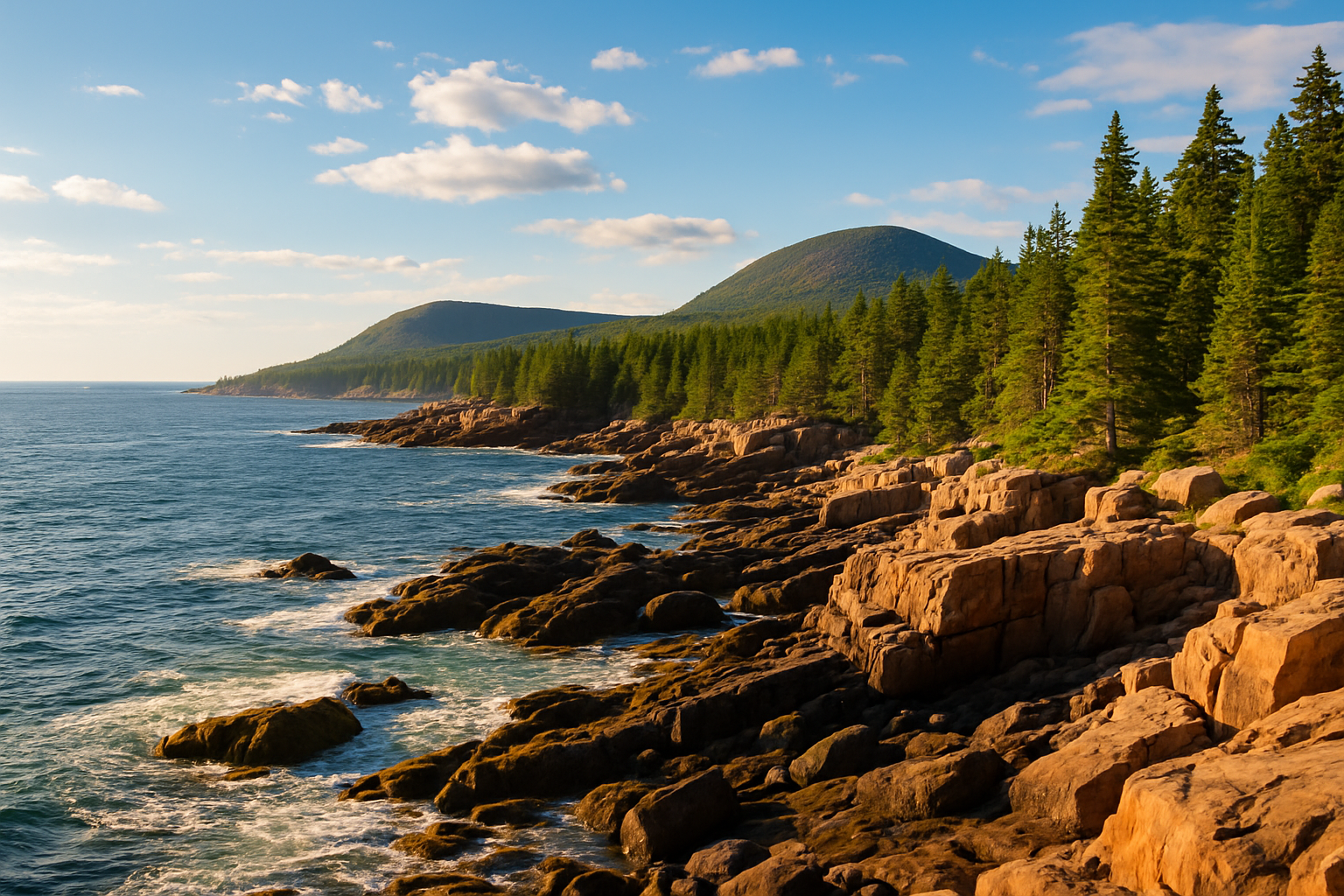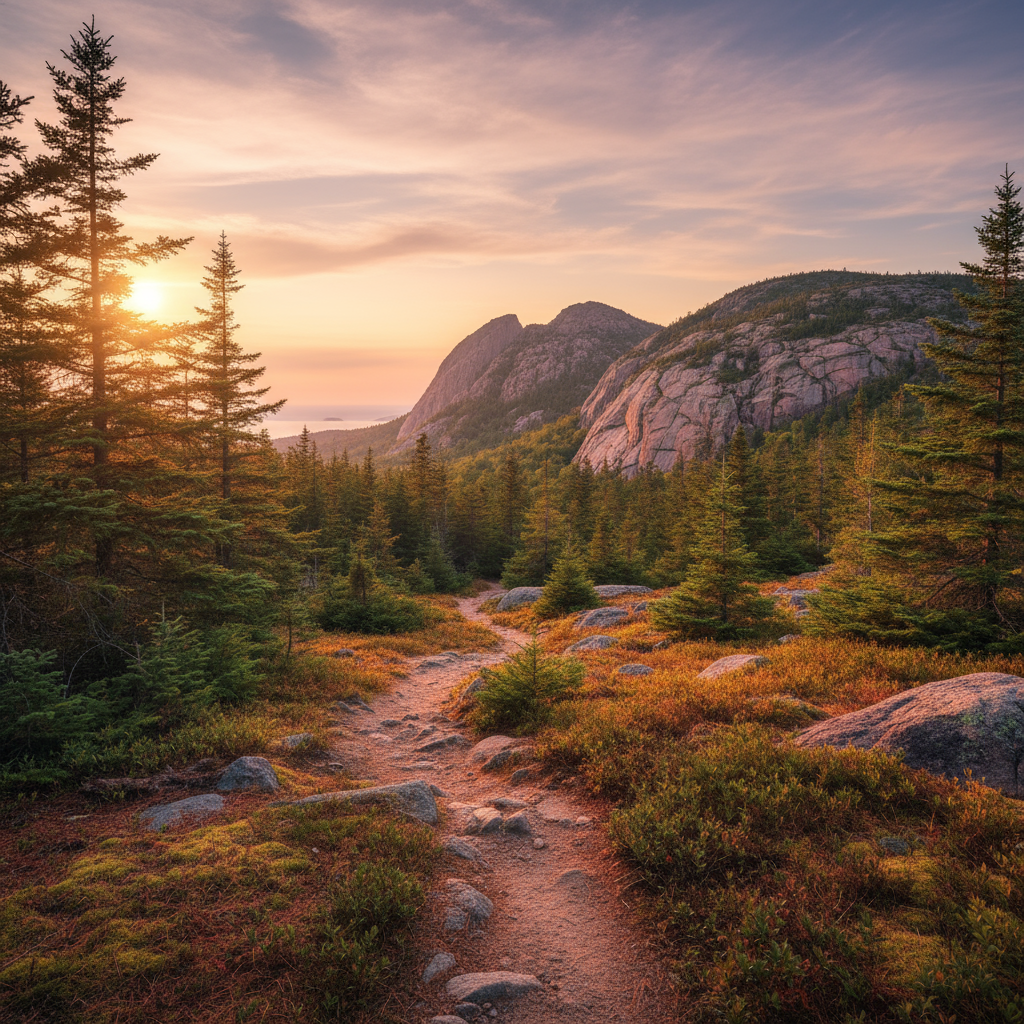🏞️ Acadia National Park: A Coastal Treasure in Maine, USA
Introduction to Acadia National Park
Acadia National Park isn’t just a destination — it’s an experience that stays with you. Tucked along Maine’s rugged Atlantic coast, Acadia blends pink granite cliffs, evergreen forests, and sweeping ocean views into one unforgettable landscape. It’s the only national park in the Northeastern United States, and it feels every bit as unique as its geography.
The park spans Mount Desert Island, Schoodic Peninsula Acadia National Park, and Isle au Haut, each with its own character. On Mount Desert Island, you’ll find the lively gateway town of Bar Harbor, the summit of Acadia National Park Cadillac Mountain, and the historic Carriage Roads built by John D. Rockefeller. Schoodic Peninsula offers quieter coastlines and dramatic surf, while Isle au Haut feels remote and wild, a perfect escape for those seeking solitude.
With more than 120 miles of hiking trails and 45 miles of Carriage Roads, Acadia is a playground for outdoor lovers. Hike to sweeping mountain vistas, cycle past stone bridges, or stroll sandy beaches like Sand Beach and Echo Lake. Wildlife watchers can spot seabirds, harbor seals, and even the occasional moose, while photographers find endless inspiration in sunrise skies and fall foliage.
This page is your complete guide to Acadia National Park. We’ve organized everything into themed sections — from accommodation and trails, to beaches, attractions, wildlife, weather, and more. Each section links to in-depth guides so you can plan your perfect trip to Acadia.
🔎 Explore Acadia National Park
- Acadia National Park Maine – discover the only U.S. national park in the Northeast, filled with coastal charm.
- Acadia National Park coastal cliffs – pink granite ledges meet the crashing Atlantic waves.
- Cadillac Mountain sunrise Acadia – the first place in the U.S. to see sunrise for part of the year.
- Carriage Roads in Acadia National Park – historic stone bridges and peaceful cycling routes built by Rockefeller.
- Beaches in Acadia National Park – from Sand Beach to Echo Lake, perfect for summer relaxation.
- Wildlife in Acadia National Park – spot birds, moose, and seals in their natural habitats.
- Bar Harbor Acadia gateway – the lively seaside town that serves as the park’s main entrance.
- Best time to visit Acadia – plan your trip around colorful fall foliage, summer hikes, or winter serenity.
🧭 Plan Your Visit: Centers, Maps & Nearby Towns
Start your Acadia adventure at Hulls Cove Visitor Center, the park’s main hub for maps, passes, and ranger advice. It’s the perfect first stop to learn about current trail conditions, seasonal programs, and updates before heading out to the quieter western side. Rangers can help you choose the best trails, explain route options, and point you toward less-crowded parts of the park like Bernard Mountain.
Be sure to carry a map of Acadia National Park—either printed or downloaded—since cell coverage is limited across Mount Desert Island and Schoodic. Even a short stop here helps you get oriented before setting out for the day.
To move between popular park areas, consider the Island Explorer Shuttle Acadia, a free seasonal service that connects Hulls Cove Visitor Center, Bar Harbor, Sand Beach, and Jordan Pond. While the shuttle doesn’t reach Bernard Mountain or Long Pond, it’s an easy and eco-friendly way to explore Acadia’s busier eastern side without parking hassles. Schedules are available online and at most hotels and visitor centers.
When choosing where to stay, the towns near Acadia make trip planning easy:
- Bar Harbor – lively base with restaurants, harbor walks, and shuttle access.
- Southwest Harbor – relaxed pace on the “quiet side,” close to Bernard and Mansell trails.
- Trenton – practical and budget-friendly, near the bridge and services.
All three towns put you within easy reach of Acadia’s highlights—from Cadillac Mountain and Jordan Pond to scenic carriage roads and coastal viewpoints.
• Start at: Hulls Cove Visitor Center (passes, maps, current conditions)
• Maps: Carry printed/downloaded trail & carriage road maps (cell is spotty)
• Shuttle: Island Explorer routes connect towns and key trailheads (seasonal)
• Bases: Bar Harbor (lively), Southwest Harbor (quiet side), Trenton (convenient)
• Close to: Cadillac Mountain, Jordan Pond, Park Loop Road, Carriage Roads
Schoodic Peninsula in Acadia National Park
Across Frenchman Bay lies one of Acadia’s best-kept secrets — the Schoodic Peninsula Acadia National Park. This section of the park, located on the mainland, offers the same rugged coastline and granite beauty as Mount Desert Island but with a quieter, more contemplative atmosphere. It’s where crashing surf meets pine-covered headlands, where seabirds circle above rocky points, and where you can still find that rare feeling of solitude within a national park.
A scenic Schoodic Loop Road curves six miles around the peninsula, tracing the Atlantic’s edge and revealing a panorama of offshore islands and distant peaks. Drivers can stop at viewpoints like Ravens Nest Acadia, where the cliffs drop dramatically to the sea, or take the short path to Schoodic Point Acadia National Park — a wide, wind-swept platform of pink granite that feels like standing at the edge of the world. On calmer days, tide pools mirror the sky; on stormy ones, waves explode against the rock with thunderous force.
Hikers will find a network of peaceful forest and coastal trails branching off from the loop road. The Anvil Trail Schoodic climbs steadily through spruce forest to a rocky overlook with sweeping views of Frenchman Bay. The Schoodic Head Trail winds up through mossy woodland to the peninsula’s highest point, while the East Trail Schoodic and Lower Harbor Trail Schoodic provide gentler coastal walks. Each route is clearly marked on the Schoodic Peninsula trail map, which also highlights restrooms, picnic areas, and key overlooks.
Camping on the peninsula is centered around the Schoodic Woods Campground Acadia, a modern, spacious site that opened in 2015. It’s connected to both trails and the Schoodic Loop Road, making it easy to explore without ever needing your car. The Schoodic Institute, located nearby, adds a unique dimension to this part of the park — a hub for art, science, and education that hosts workshops, lectures, and seasonal programs about Acadia’s changing environment.
Visitors can pick up a Schoodic Peninsula map or download the map of Schoodic Peninsula before setting out, as cell reception can be spotty. Whether you come for a quiet day drive, a weekend of camping, or a sunrise over the cliffs, Schoodic Peninsula offers a wilder, more peaceful side of Acadia — a reminder that even within a popular park, there’s still room to feel alone with the sea.
• The Schoodic Peninsula is the only part of Acadia National Park located on the mainland.
• The Schoodic Woods Campground opened in 2015 and features some of the park’s most spacious campsites.
• The Schoodic Loop Road stretches six miles around the coast, offering unmatched ocean views and pullouts for photographers.
• The Schoodic Institute serves as a hub for environmental education, research, and creative programs inside the park.
• With fewer visitors than Mount Desert Island, Schoodic Acadia offers peace, wildlife, and pristine coastal scenery.
Mountains in Acadia National Park
Acadia is defined by its mountains — granite domes carved by glaciers that rise directly from the Atlantic and shape every view. The Mountains in Acadia National Park are more than backdrops; they are the heart of the park’s identity. From sunrise on rugged ridges to mist drifting through spruce valleys, these summits capture the wild spirit of Maine’s coast.
Among the Mountains in Acadia National Park, Cadillac Mountain stands tallest, famous for its panoramic sunrise views over Frenchman Bay. Nearby, Beehive Mountain delivers one of Acadia’s most thrilling hikes, where iron rungs lead to sweeping ocean vistas. Together with many other peaks, they offer visitors endless ways to experience the park’s blend of mountain and sea.
The Bubble Mountains add another layer to Acadia’s character. Rising side by side above Jordan Pond, North Bubble and South Bubble are smaller than Cadillac yet equally iconic. South Bubble is home to Bubble Rock, the park’s most photographed glacial erratic, while North Bubble offers broad, quieter views toward the island’s lakes and ridgelines. Hikers often combine the two on the Bubbles Trail, making this duo one of Acadia’s most popular short hikes.
• Cadillac Mountain Acadia National Park — tallest summit, iconic sunrise views, accessible by the Cadillac Mountain Summit Road or the Cadillac Mountain Summit Trail
• Champlain Mountain Acadia National Park — Precipice Trail, dramatic cliff climbs
• Beehive Mountain — short but daring ladder-rung scramble
• Dorr Mountain Acadia — steep ladder trails, overlooks of Bar Harbor
• Pemetic Mountain — views over Jordan Pond & the Bubbles
• Gorham Mountain — moderate hike, Otter Cliffs & coastal vistas
• Day Mountain Acadia National Park — carriage road to summit, views of Cranberry Isles
• Penobscot Mountain Acadia — granite ridges, classic loop with Sargent
West Side Peaks
• Beech Mountain Acadia National Park — historic fire tower, lake & forest panoramas
• Acadia Mountain — moderate hike above Somes Sound
• Saint Sauveur Mountain — rugged trail, quieter ridgeline views
• Mansell Mountain — mossy forest, solitude on the western ridges
• Norumbega Mountain — wooded climb with fjard-like outlooks
• Bernard Mountain — peaceful trails with ocean and harbor views
• Flying Mountain Acadia — short climb near Somes Sound, great for families
Other Highlights
• Sargent Mountain Acadia — second-highest summit, alpine tarns & ridges
• North Bubble Mountain — unique views over Jordan Pond
• South Bubble Mountain — famous for the “Bubble Rock” glacial erratic
• Huguenot Head — quieter spur near Beehive & Champlain
Each summit links to its own page with trails, maps, photos, and insider tips — making this the ultimate hub for exploring Acadia’s mountains.
Why These Mountains Matter
Acadia’s mountains aren’t just trailheads or viewpoints — they are the park’s living backbone. From Cadillac at sunrise to Beehive’s cliffside drama and Beech Mountain’s western panoramas, each summit blends ocean, forest, and granite in unforgettable ways. Together, they create one of the most scenic hiking landscapes in the United States. The Acadia Mountains in Maine stand apart for how they rise directly from the Atlantic, combining rugged coastal cliffs with inland ridges and forested valleys. Nowhere else in New England can visitors experience such a compact yet diverse collection of peaks, each telling its own story of geology, wildlife, and adventure.
🏔️ Hiking & Trails in Acadia National Park
There’s something unforgettable about Hiking Acadia National Park. The moment you step onto the trail, the air feels different — clean, cool, and scented with pine and ocean spray. Light filters through spruce branches, gulls call overhead, and the granite beneath your feet glows soft pink in the sun. With more than 120 miles of routes, Acadia offers a trail for every mood and every hiker. Some are gentle coastal walks perfect for reflection; others climb steeply across bare granite to views that stretch for miles over forest and sea. It’s a park that invites you to explore slowly, to stop often, and to notice the details that make this place so alive.
Each route reveals a different side of the island. Around Jordan Pond, reflections of North Bubble and South Bubble Mountain ripple in perfect symmetry while loons call across the water. Ocean Path follows the coastline, where waves crash and scatter against the rocks near Thunder Hole and Sand Beach. Families stop to watch the surf, children balance along the ledges, and photographers chase the changing light. For the adventurous, Hiking Acadia National Park can mean tackling the Beehive Trail Acadia or Precipice Trail Acadia — steep climbs with iron rungs and thrilling exposure, rewarded by views over Frenchman Bay that feel like they belong to another world.
The network of Trails in Acadia National Park ties all these moments together. The Wonderland Trail winds through quiet forest to tide pools filled with sea stars and shells. Jesup Path crosses peaceful birch groves, while Great Meadow Loop wraps around Dorr Mountain Acadia through open fields and marshland. Higher up, the ridges of Penobscot Mountain Acadia and Sargent Mountain form a sweeping loop where lakes shimmer far below and the horizon dissolves into the Atlantic. Even the historic Carriage Roads, built by John D. Rockefeller Jr., bring their own rhythm — broad gravel paths that curve gently beneath canopies of maple and beech, crossing stone bridges and passing overlooks that seem designed for pausing.
Every season reshapes the Trails in Acadia National Park. Acadia in Spring brings the rush of melting snow and the first wildflowers. Acadia National Park in summer fills the air with the hum of insects and the distant sound of waves. Acadia in the fall turns the forest into a canvas of crimson and gold, while an Acadia National Park winter transforms everything into stillness and light. Through it all, Hiking Acadia National Park remains the same — a reminder that the best way to know Acadia is to walk it, to feel it beneath your feet, and to let the island’s quiet power stay with you long after the trail ends.
Some trails in Acadia rise beyond simple paths — they’re experiences that define the park itself. These signature routes, like the Beehive Trail Acadia, Precipice Trail, Jordan Pond Trail Acadia, and Cadillac Mountain Trail, each deserve their own story. Others, such as Wonderland Trail, Jesup Path, or Flying Mountain Trail, reveal the quieter side of the island — short walks that carry the same sense of wonder in smaller steps. As you explore further through Trails in Acadia National Park, you’ll find pages dedicated to both — the headline hikes that challenge and inspire, and the hidden gems that invite you to slow down and look closer.
• Precipice Trail – Iron rungs up Champlain Mountain, thrilling & exposed
• Beehive Trail – Short but daring ladder climb with ocean views
• Ocean Path – Family-friendly walk from Sand Beach to Thunder Hole
• Jordan Pond Path – Easy lakeside loop with views of the Bubbles
• Wonderland Trail – Gentle coastal walk, great for tide pooling
• Cadillac North Ridge Trail – Scenic route to Acadia’s highest summit
• Dorr Mountain South Ridge Trail – Challenging climb near Bar Harbor
• Pemetic Mountain Loop – Ridge and ledges with Jordan Pond vistas
• Jesup Path & Great Meadow Loop – Peaceful forest boardwalks
• Flying Mountain Trail – Short climb with harbor and island views
🚗 Scenic Routes & Iconic Roads
One of the easiest — and most beautiful — ways to experience Acadia National Park is from behind the wheel. The famous Park Loop Road is a 27-mile scenic drive that winds past many of the park’s most iconic destinations. Along the way you’ll find stops at Sand Beach, Thunder Hole, Otter Cliffs, Jordan Pond, and numerous overlooks with views of Frenchman Bay and the offshore islands. It’s the perfect route for first-time visitors and a highlight even for those returning.
For a quieter journey, explore the historic carriage roads of Acadia National Park. Built in the early 1900s by John D. Rockefeller Jr., these 45 miles of motor-free gravel paths weave through forests, around lakes, and across elegant stone bridges. They’re a favorite for walking, running, cycling, and even winter cross-country skiing.
Speaking of cycling, the bike trails in Acadia National Park — especially the carriage roads — cater to all skill levels. You can rent a bike in Bar Harbor or bring your own, then set out to enjoy smooth rides past Jordan Pond, Eagle Lake, and secluded woodland stretches. Whether by car, bike, or on foot, Acadia’s roads and routes offer some of the most scenic miles in the National Park system.
• Park Loop Road: 27-mile drive past Sand Beach, Thunder Hole, Otter Cliffs, and Jordan Pond
• Carriage Roads: 45 miles of motor-free gravel paths built by John D. Rockefeller Jr.
• Stone Bridges: Historic carriage road bridges, perfect photo stops
• Cycling: Bike rentals in Bar Harbor or bring your own
• Best Views: Frenchman Bay overlooks, lakes, and forested valleys
🏕️Where to Stay: Camping, Inns & Lodging Options
If you want to wake up to the sound of waves or birdsong, camping in Acadia National Park is the classic choice. The park has four official campgrounds: Blackwoods (close to Bar Harbor), Seawall (near the quiet side of Mount Desert Island), Schoodic Woods (on the Schoodic Peninsula), and Duck Harbor (on Isle au Haut, accessible only by ferry). Each offers its own mix of forest settings, ocean breezes, and access to nearby trails — but in peak season, campsites fill quickly, so reservations are essential.
Not a tent camper? No problem. There are plenty of places to stay near Acadia National Park, from simple motels to boutique inns with plenty of character. Cozy Acadia inns often feature porches, fireplaces, and hearty breakfasts, while budget-friendly Acadia motels provide straightforward comfort close to trailheads and shuttles.
For families or longer stays, cottages near Acadia offer extra space, privacy, and the chance to settle in like a local — many come with kitchens, water views, and peaceful locations just outside the park. If you’re seeking more upscale amenities, resorts near Acadia National Park deliver pools, spas, and panoramic views of the coast. A standout is the Acadia Village Resort in Maine, a favorite for its family-friendly atmosphere and easy access to Bar Harbor.
Finally, if variety and convenience matter most, you can’t go wrong with the wide range of Acadia hotels, from modern chains with familiar comforts to historic lodges that have hosted generations of park visitors. Whatever your style of travel, Acadia has a lodging option that fits.
• Campgrounds: Blackwoods, Seawall, Schoodic Woods, Duck Harbor (Isle au Haut)
• Inns: Charming stays with porches, fireplaces & homemade breakfasts
• Motels: Affordable, convenient options near the park
• Cottages: Quiet coastal rentals ideal for families & longer stays
• Resorts: Luxury stays with pools, spas & water views (Acadia Village Resort is a favorite)
• Hotels: From modern chains to historic lodges in Bar Harbor & beyond
🏖️ Beaches in Acadia National Park
Closer to the ocean, Sand Beach Acadia National Park is a postcard-perfect crescent of golden sand framed by granite headlands and spruce forest. The Atlantic stays brisk even in August, but that chill doesn’t stop visitors from wading in for a refreshing dip or strolling along the shoreline. The view alone — deep blue waves breaking against pink-hued cliffs — makes this one of the park’s most photographed and beloved locations. Early morning light turns the water a luminous turquoise, and fog sometimes drifts in from the open sea, giving it a dreamlike beauty that changes with every hour of the day.
For those who prefer calm, freshwater swimming, Echo Lake Beach in Maine provides a gentler alternative to the Atlantic’s chill. Nestled between Beech Mountain and Beech Cliffs, its sheltered waters are warmed by the sun and patrolled by lifeguards in summer. The lake’s clear surface mirrors the trees and cliffs that rise above it, creating one of Acadia’s most peaceful spots for picnicking or a cooling dip after a long hike. Families often spend full afternoons here, enjoying the sand, the mountain backdrop, and the soft sound of loons calling across the lake.
Beyond these well-known destinations, the variety of Acadia National Park beaches reveals how diverse the coastline truly is — from peaceful cobblestone coves to rugged, wave-carved shores. Hunters Beach and Little Hunters Beach invite visitors to explore smooth cobblestones that shift and sing with each wave. The experience is as much about sound as sight — the rhythmic roll of surf over rounded stones is hypnotic, especially on calm afternoons. Boulder Beach, found along the Park Loop Road, is a favorite for sunrise photographers, where glowing light and crashing waves transform the shoreline into a symphony of color and motion. Nearby, Seal Harbor Beach offers a smaller, family-friendly shoreline near the village, ideal for peaceful walks and quiet reflection.
Whether you’re dipping your toes in the surf, exploring tide pools, or sitting on a sun-warmed rock to watch the waves, the beaches in Acadia National Park reveal the gentler side of this rugged landscape. Each shoreline tells its own story — of tides and time, of wind shaping stone, and of a park that balances wild beauty with moments of stillness.
If you’re ready to explore them all, dive into our full guide to Acadia National Park beaches for inspiration, hidden coves, and local favorites along Maine’s unforgettable coast.
• Sand Beach Acadia National Park — golden sand, turquoise surf, and dramatic cliff views.
• Echo Lake Beach — freshwater swimming with lifeguards during summer months.
• Hunters Beach & Little Hunters Beach — peaceful coves lined with smooth cobblestones.
• Boulder Beach — a striking sunrise spot along the Park Loop Road.
• Seal Harbor Beach — small, family-friendly shoreline near the village of Seal Harbor.
• Discover the best beaches in Acadia National Park for swimming, photography, and relaxation along Maine’s scenic coast.
🐿️ Wildlife, Birds & Coastal Creatures
Wildlife sightings are one of the joys of visiting Acadia National Park. With habitats ranging from rocky coastlines to spruce-fir forests, the park supports a wide variety of animals. On land, you might spot white-tailed deer, red foxes, or the occasional porcupine ambling across a trail. Along the shoreline, look for harbor seals hauled out on rocks, and if you’re lucky, you might even glimpse mink or otters near tidal inlets.
Birders won’t be disappointed either. The birds of Acadia National Park include more than 300 recorded species — from tiny warblers flitting through the trees to the haunting call of loons across the lakes. Overhead, bald eagles and peregrine falcons soar on coastal thermals, while seabirds like gulls, guillemots, and cormorants patrol the shore. Spring and fall migrations bring a surge of avian activity, but there’s always something to see year-round.
Whether you’re scanning the skies, peering into tide pools, or quietly walking the woods, Acadia’s wildlife adds a layer of wonder to every visit. Just remember the golden rule: watch from a distance and let the animals stay wild.
• Land: White-tailed deer, red foxes, porcupines, snowshoe hares
• Sea: Harbor seals, mink, river otters, seabirds along the coast
• Birds: Bald eagles, peregrine falcons, loons, warblers, cormorants
• Best Seasons: Spring & fall migrations for peak bird activity
• Reminder: Keep your distance — let Acadia’s wildlife stay wild
🧺 What to Do in Acadia National Park
Planning your first visit and not sure where to begin? There’s plenty to do — Acadia National Park style — whether you’re chasing adventure, scenery, or simply a place to unwind. Hikers can tackle Cadillac Mountain, Precipice, or the Beehive, while those after a gentler pace can stroll the Jordan Pond Path or enjoy a family loop around Echo Lake.
Not every experience requires lacing up your boots. The Park Loop Road provides a stunning 27-mile scenic drive with stops at Sand Beach, Otter Cliffs, and Thunder Hole. The historic carriage roads invite you to walk, jog, or cycle through Acadia’s heart, crossing elegant stone bridges and wooded valleys.
Low-key joys are everywhere: a picnic with popovers at Jordan Pond House, skipping stones at Echo Lake, or watching waves explode against the rocks at Thunder Hole. Beyond that, wildlife watching, photography, stargazing, and ranger-led programs all offer fresh ways to connect with the park. And if you’d rather keep things simple, remember that some of Acadia’s best views are just steps from the road.
Whether you’re here for a few hours or a few days, Acadia National Park offers something for everyone — and the freedom to explore entirely at your own pace.
• Hike: Cadillac Mountain, Precipice Trail, Beehive Trail
• Drive: Park Loop Road with stops at Sand Beach & Thunder Hole
• Cycle: 45 miles of historic carriage roads
• Relax: Jordan Pond picnics, Echo Lake swimming
• Explore: Wildlife watching, photography, stargazing, ranger programs
📚 History, Weather & Best Time to Go
Acadia National Park history begins in 1916, when local advocates and national leaders came together to protect the wild beauty of Mount Desert Island. Originally established as Sieur de Monts National Monument, it became Lafayette National Park in 1919 and was renamed Acadia in 1929. Much of what visitors enjoy today — the carriage roads, stone bridges, and scenic overlooks — are part of that early vision, with major contributions from philanthropist John D. Rockefeller Jr.
As for the weather in Acadia, the Atlantic Ocean is the park’s constant companion. Expect cool breezes, foggy mornings, and sudden changes in the sky. Even in July and August, you’ll want a light jacket handy, especially on exposed summits like Cadillac Mountain.
So, what’s the best time to visit Acadia National Park? That depends on the kind of experience you want:
- Acadia National Park in Summer – Warm weather, long daylight hours, and all campgrounds and services open. Perfect for swimming, biking, hiking, and family vacations.
- Acadia In The Fall – Brilliant foliage transforms the park into one of New England’s most iconic autumn destinations. Cooler air and lighter crowds make it ideal for hiking and photography.
- Acadia In Spring – Wildflowers line the trails, waterfalls surge with snowmelt, and Bar Harbor wakes up for the season. Fewer visitors make it a peaceful time to explore.
- Acadia National Park Winter – Acadia becomes a quiet wonderland. Snow-dusted forests, frozen lakes, and near-empty trails invite snowshoeing, cross-country skiing, and solitude on the carriage roads.
Every season offers its own rewards — the best time to go is simply the time that matches your adventure style.
• Acadia was the first national park established east of the Mississippi (1916)
• John D. Rockefeller Jr. built 45 miles of carriage roads & 16 stone bridges
• Cadillac Mountain is one of the first places in the U.S. to see sunrise
Quick Look: Best Times to Visit
• Summer: Warm, busy, everything open — classic family trips
• Fall: Peak foliage, crisp air, great for hiking & photos
• Spring: Wildflowers, waterfalls, fewer crowds
• Winter: Snowy solitude, skiing & snowshoeing on carriage roads
🌟 Must-See Acadia National Park Attractions
Acadia may be known for its sweeping landscapes, but it’s the signature attractions that give the park its soul. These iconic places capture the essence of Mount Desert Island — from granite peaks to pounding surf. The major Acadia National Park attractions include Cadillac Mountain, Thunder Hole, Jordan Pond, Sand Beach, and the historic carriage roads.
Each of these spots defines the Acadia experience in its own way. At Cadillac Mountain, visitors flock to see sunrise spill across Frenchman Bay, while Thunder Hole delivers a dramatic display as waves boom against the rocky shore. Jordan Pond offers serenity and iconic views of the Bubbles, complete with its famous popovers at the Jordan Pond House. Sand Beach is a small but stunning ocean cove, framed by cliffs and evergreen forest. And the carriage roads, built by John D. Rockefeller Jr., provide 45 miles of peaceful, motor-free paths perfect for biking, walking, and soaking in the scenery.
Together, these attractions form the perfect foundation for a first-time Acadia itinerary — but they’re also the touchstones that keep repeat visitors coming back year after year.
• Cadillac Mountain: Iconic summit & sunrise views
• Thunder Hole: Waves crash & boom against rocky cliffs
• Jordan Pond: Scenic lake with views of the Bubbles
• Sand Beach: Ocean cove surrounded by granite cliffs
• Carriage Roads: 45 miles of motor-free paths & stone bridges
💵 Entry Fees & Guided Tours
Before starting your adventure, be sure to purchase the Acadia National Park entry fee. A standard pass is valid for seven consecutive days and can be purchased online, at park visitor centers, or at self-service kiosks. If you plan on visiting more than once a year, an annual Acadia pass (or the nationwide America the Beautiful pass) is a great value and covers entry to all national parks.
For a more relaxed experience, consider one of the many Acadia tours from Bar Harbor. Local companies offer a variety of options — from lighthouse cruises and lobster boat excursions to guided van tours that cover park highlights without the hassle of driving or parking. These tours are especially convenient for first-time visitors, families, or anyone who wants a richer perspective on Acadia’s history, wildlife, and scenery.
Whether you choose to explore on your own or let a guide lead the way, Acadia offers endless ways to discover its beauty.
• Entry Fee: 7-day pass, available online or at kiosks
• Annual Pass: Save if visiting more than once a year
• America the Beautiful: Covers all U.S. national parks
• Tours: Bar Harbor cruises, van tours & lobster boat trips
• Tip: Book tours early in peak summer and fall
📸 Iconic Views, Lighthouses & Local Events
Few places capture the spirit of Acadia National Park like the Bass Harbor Head Light. Perched on rocky cliffs at the southwestern tip of Mount Desert Island, this Acadia lighthouse is one of the park’s most-photographed landmarks. At sunset, when the sky glows orange and the waves crash below, it’s a view you’ll never forget.
But Bass Harbor is just the beginning. The park is full of iconic views and photo spots — from tide pools along the Schoodic Peninsula to the mirrored surface of Jordan Pond, from granite ridges on Cadillac Mountain to hidden coves near Compass Harbor. Whether you’re framing a perfect sunrise or just snapping a phone shot along the trail, the pictures of Acadia National Park you take home will be some of your trip’s best souvenirs.
To round out your experience, keep an eye on the Acadia National Park events calendar. Highlights include the Acadia Night Sky Festival, a celebration of the park’s incredible dark skies, as well as ranger-led programs, bird festivals, and seasonal events in Bar Harbor, Winter Harbor, and Trenton. These gatherings connect you to both the natural beauty and the local community that make Acadia so special.
• Bass Harbor Head Light: Iconic lighthouse, best at sunset
• Iconic Views: Cadillac Mountain, Jordan Pond, Schoodic surf
• Photography: From pro shots to simple snapshots — Acadia delivers
• Events: Acadia Night Sky Festival, ranger programs, local festivals
• Nearby Towns: Seasonal happenings in Bar Harbor, Winter Harbor & Trenton
❤️ Why We Love It
From its rugged coastlines to its granite peaks, Acadia National Park offers a little bit of everything we love about the great outdoors — and it’s all wrapped in the cozy charm of coastal Maine. You can climb a mountain at sunrise, explore tide pools at low tide, cycle the quiet carriage roads, or relax with a picnic by Jordan Pond. Every experience feels both adventurous and intimate, a reminder of how wild places restore the soul.
What makes Acadia so special is its balance: dramatic scenery that rivals the West, yet a welcoming scale that invites you to slow down and savor each view. Whether you’re a first-time visitor chasing iconic spots like Cadillac Mountain and Bass Harbor Head Light, or a returning traveler discovering hidden coves and quiet trails, Acadia has a way of leaving you refreshed and inspired.
Bookmark this guide, pack your gear, and come see why Acadia isn’t just one of the most beloved national parks in America — it’s a place you’ll carry with you long after you leave.
Thanks for exploring Acadia with us. From sunrise on Cadillac Mountain to quiet coves along Schoodic, may your adventures be unforgettable.
Until next time, happy trails from TheParkTrail.com.
Plan smarter with these trusted links:
![]() Follow The Park Trail Updates
Follow The Park Trail Updates
Click the orange RSS icon to subscribe to The Park Trail RSS Feed and get automatic alerts whenever new parks, trails, or travel stories are published.
To follow, simply copy the feed link when prompted and paste it into your favourite RSS reader (like Feedly, NewsBlur, or Inoreader) — or use your browser’s built-in RSS option. You’ll always be the first to know what’s new across America’s national parks.
Recent Articles
-
Precipice Trail Acadia National Park | Iconic Cliff Hike
Nov 05, 25 04:41 PM
Climb the thrilling Precipice Trail Acadia National Park — steep cliffs, iron rungs, and sweeping ocean views make this Acadia hike unforgettable. -
Cadillac Mountain South Ridge Trail – Acadia’s Scenic Ridge Hike
Oct 31, 25 04:44 PM
Follow the Cadillac Mountain South Ridge Trail for sweeping ocean views, granite ridges, and pine forests on Acadia’s most scenic summit hike. -
Cadillac Mountain Trail | Acadia National Park’s Iconic Summit Hike
Oct 30, 25 10:17 PM
Cadillac Mountain Trail offers Acadia’s best hike—granite ridges, ocean views, and sunrise scenes over Bar Harbor from Maine’s highest peak.
Want insider tips on Acadia and beyond? Join our free newsletter and get fresh park updates, planning advice, and hidden gems delivered to your inbox.
Sign Up
